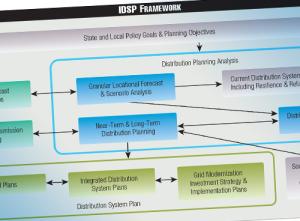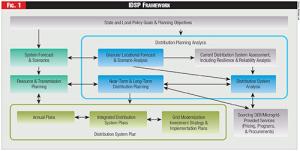What You Need to Know
Jeff Loiter is a Technical Director in the Center for Partnerships & Innovation at NARUC where he oversees CPI’s energy distribution research portfolio, including smart grid and grid modernization, distributed energy resources integration and interconnection, virtual power plants, and related issues in ratemaking and utility business models.
Taylor Fitzgerald is a Communications Coordinator for the NARUC Center for Partnerships & Innovation where she develops and executes outreach strategies to enhance the visibility of essential resources, trainings, and other activities that assist state commissions contending with complex current and emerging issues.
The reliability, resilience, safety, and efficiency of utility services have long been priorities for both regulators and customers. The electric distribution system is evolving as a result of new technologies and the transition of our energy systems to a more sustainable model, making it more challenging to achieve these standards. One approach to managing these two trends is Integrated Distribution System Planning (IDSP).

IDSP is a systematic approach to reach state and utility objectives for grid planning and design while also meeting customer needs. It not only supports a safe and reliable grid but also the integration and use of distributed energy resources (DERs) and provides a grid modernization roadmap.
Enhanced planning processes for the grid offer numerous benefits to stakeholders, including state agencies, customers, and utilities. These improvements can foster more transparent and comprehensive plans for distribution system investments and other expenditures and increase opportunities for positive stakeholder engagement.
Instituting a robust IDSP process is also a critical step in advancing more comprehensive planning processes that include a holistic assessment of resource requirements and grid modernization strategies across multiple jurisdictions (such as communities, states, and regions) and parts of the electric system (such as distribution, transmission, and interregional transmission.)
Additionally, refined planning processes allow for better consideration of future uncertainties and provide tools to evaluate all solutions in terms of cost and risk. Customers and third-party providers are also empowered to propose grid solutions and actively participate in planning for how DERs can deliver valuable grid services.
"Integrated planning is becoming essential for addressing complexity, uncertainty, and coordination in the electricity system," said Joseph Paladino, a senior advisor within the U.S. Department of Energy's Office of Electricity. "In particular, there is an urgent need to bring together all of the participants and stakeholders in a meaningful way to develop a rational, forward-looking grid investment strategy."
Along with the potential benefits of IDSP, there are key challenges to employing IDSP that need to be addressed for effective implementation. First, there is a need to clearly articulate state and local policy goals and objectives, which is essential for guiding planning efforts. Additionally, developing load forecasts with sufficient locational and temporal detail is crucial for accurate future demand projections and grid adequacy.
Furthermore, detailed distribution system assessments are required to identify the worst-performing circuits and assess risk profiles based on threats. Last, quantifying the benefits of grid reliability and the contributions of distributed energy resources is vital for demonstrating their value and justifying necessary investments.
There are various tools available to address these challenges provided by organizations such as the National Association of Regulatory Utility Commissioners (NARUC) and Lawrence Berkeley National Laboratory (Berkeley Lab).
 Figure 1 - IDSP Framework
Figure 1 - IDSP Framework
NARUC produces resources and hosts training and collaboration opportunities for public utility commissions and other state agencies to support understanding of IDSP. These resources are available on the NARUC Distribution Systems and Planning webpage at www.naruc.org/core-sectors/energy-resources-and-the-environment/distribu... and Berkeley Lab's IDSP webpage at emp.lbl.gov/projects/integrated-distribution-system-planning.
NARUC IDSP resources include the recent report, "Aggregated Distributed Energy Resources in 2024: The Fundamentals," and the March 2024 IDSP training series recordings.
NARUC's new report on the fundamentals of aggregated distributed energy resources (ADERs) expands on existing research and showcases leading examples of ADER pricing and programs. It aims to provide commissioners and staff at public utility commissions and state energy offices with a comprehensive understanding of ADER grid services, valuation methods, and compensation approaches.
The IDSP training series was hosted by NARUC, Berkeley Lab, and the National Association of State Energy Officials to provide well-rounded training on essential IDSP topics for state agencies. Topics covered included key IDSP concepts, load forecasting, DER planning, identifying grid needs and evaluating investment options, and recovering and allocating costs.
 Jeffrey Loiter: NARUC’s new report on aggregated distributed energy resources expands on existing research and showcases examples of ADER pricing and programs. It aims to provide commissioners and staff at PUCs and state energy offices with a comprehensive understanding of ADER grid services, valuation methods, and compensation approaches.
Jeffrey Loiter: NARUC’s new report on aggregated distributed energy resources expands on existing research and showcases examples of ADER pricing and programs. It aims to provide commissioners and staff at PUCs and state energy offices with a comprehensive understanding of ADER grid services, valuation methods, and compensation approaches.
Recent tools produced by Berkeley Lab include an Interactive Decision Framework for IDSP and a data visualization and catalog of State Requirements for Electric Distribution System Planning. The IDSP framework covers seventeen key topics, including forecasting loads and DERs, scenario analysis, hosting capacity analysis, and threat-based risk assessment, among others.
For each topic, the framework provides an overview, outlines stakeholder roles and responsibilities, presents best practices, highlights examples of state and utility practices, includes flow charts, identifies tools, and offers additional resources to support effective planning and implementation.
See Figure One.
State Requirements for Electric Distribution System Planning reviews the requirements for electric utilities to file distribution system plans in twenty U.S. jurisdictions, highlighting the shift from internal-facing utility planning to public filings, stakeholder engagement, and regulatory review.
 Taylor Fitzgerald: The IDSP training series was hosted by NARUC, Berkeley Lab, and the National Association of State Energy Officials to provide well-rounded training on essential IDSP topics for state agencies.
Taylor Fitzgerald: The IDSP training series was hosted by NARUC, Berkeley Lab, and the National Association of State Energy Officials to provide well-rounded training on essential IDSP topics for state agencies.
It details various plan types, including plans that focus on grid modernization, DERs, and expedited cost recovery for certain distribution investments, with a focus on integrated distribution plans that align with state and local policies.
"Utilities have been doing distribution system planning since they first began operating electricity systems," said Lisa Schwartz, a senior energy policy researcher and strategic advisor for Berkeley Lab's Energy Markets and Policy Department. "The difference is that we are now trying to both make that process transparent to stakeholders and regulators and to use advanced analytical methods to address grid modernization needs and the growth in distributed energy resources."
Stay informed on upcoming IDSP activities and resources by visiting the NARUC Distribution Systems and Planning webpage at www.naruc.org/core-sectors/energy-resources-and-the-environment/distribu.... NARUC will host in-person IDSP workshops open to state agency officials in three locations between December 2024 and April 2025. Direct questions to NARUC CPI Technical Director Jeff Loiter at jloiter@naruc.org.



